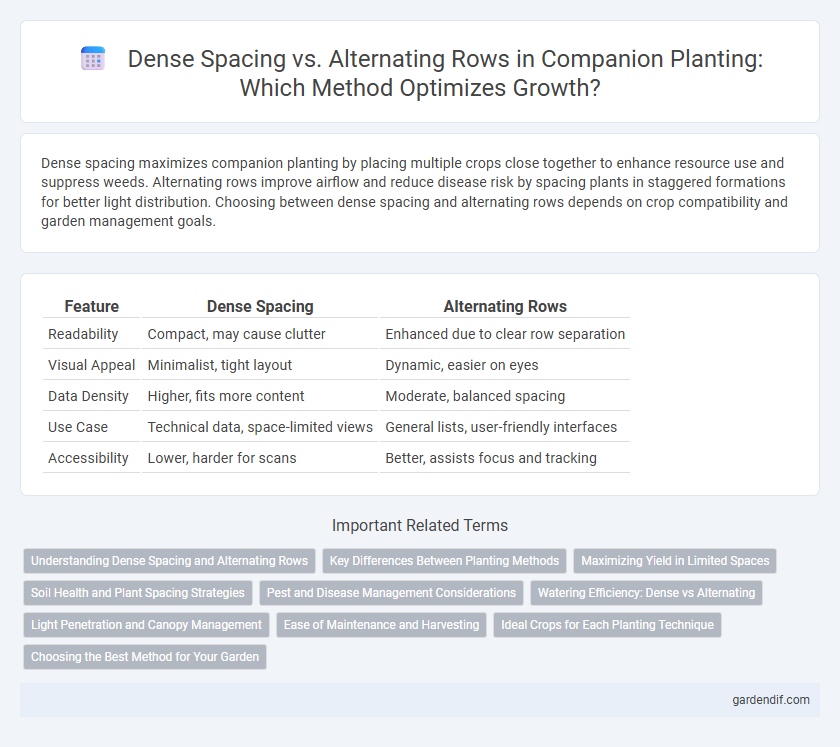
Dense spacing vs alternating rows Illustration
Dense spacing maximizes companion planting by placing multiple crops close together to enhance resource use and suppress weeds. Alternating rows improve airflow and reduce disease risk by spacing plants in staggered formations for better light distribution. Choosing between dense spacing and alternating rows depends on crop compatibility and garden management goals.
Table of Comparison
| Feature | Dense Spacing | Alternating Rows |
|---|---|---|
| Readability | Compact, may cause clutter | Enhanced due to clear row separation |
| Visual Appeal | Minimalist, tight layout | Dynamic, easier on eyes |
| Data Density | Higher, fits more content | Moderate, balanced spacing |
| Use Case | Technical data, space-limited views | General lists, user-friendly interfaces |
| Accessibility | Lower, harder for scans | Better, assists focus and tracking |
Understanding Dense Spacing and Alternating Rows
Dense spacing arranges companions closely together, maximizing the use of available space to foster intimate interactions and efficient communication. Alternating rows, however, position companions in staggered lines that enhance visibility and reduce obstruction, promoting better engagement across the group. Both methods influence social dynamics and comfort, with dense spacing favoring proximity and alternating rows improving sightlines and interaction flow.
Key Differences Between Planting Methods
Dense spacing involves planting companion plants closely together to maximize ground coverage and suppress weeds effectively, enhancing microclimate conditions and moisture retention. Alternating rows separate different plant species in distinct rows, facilitating easier access for maintenance and reducing competition for nutrients and sunlight. These planting methods differ primarily in spatial arrangement, influencing plant growth dynamics, pest control efficacy, and overall garden productivity.
Maximizing Yield in Limited Spaces
Dense spacing in companion planting maximizes yield by utilizing every available inch of soil, promoting efficient resource use among plants. Alternating rows enhance airflow and reduce pest buildup, which can improve plant health and productivity in tight areas. Optimizing the balance between dense spacing and alternating rows ensures high crop output while maintaining soil vitality and minimizing disease risks.
Soil Health and Plant Spacing Strategies
Dense spacing in companion planting enhances soil health by reducing weed growth and increasing organic matter through mulching effects, while alternating rows improve air circulation and reduce disease pressure by preventing overcrowding. Optimizing plant spacing balances nutrient uptake and root competition, fostering healthier growth and higher yields. Integrating dense and alternating row strategies supports diverse microbial activity and efficient resource use in the soil ecosystem.
Pest and Disease Management Considerations
Dense spacing in companion planting can create a microenvironment that increases humidity and reduces airflow, potentially promoting fungal diseases and pest infestations. Alternating rows improve air circulation, which helps to minimize the risk of pests like aphids and diseases such as powdery mildew by disrupting their spread. Effective pest and disease management often involves balancing plant density and arrangement to optimize natural pest control while maintaining plant health.
Watering Efficiency: Dense vs Alternating
Dense spacing in companion planting enhances watering efficiency by maximizing soil moisture retention and reducing evaporation through overlapping foliage. Alternating rows improve air circulation, which can decrease water loss but may require more frequent irrigation to compensate for increased exposure. Selecting between dense spacing and alternating rows depends on the crop's water needs and local climate conditions to optimize hydration and plant health.
Light Penetration and Canopy Management
Dense spacing in companion planting reduces light penetration, limiting photosynthesis and potentially stressing plants, while alternating rows improve light distribution by allowing more sunlight to reach lower canopy layers. Effective canopy management in alternating rows enhances airflow and sunlight exposure, promoting healthier growth and higher yields. Optimizing row patterns balances plant competition and maximizes overall garden productivity.
Ease of Maintenance and Harvesting
Dense spacing in companion planting improves ease of maintenance by reducing weed growth and maximizing space utilization, allowing quicker access for harvesting. Alternating rows facilitate better airflow and sunlight penetration, which can decrease plant disease and simplify the identification of individual crops during harvest. Choosing between dense spacing and alternating rows depends on crop type and garden layout, influencing overall productivity and labor efficiency.
Ideal Crops for Each Planting Technique
Dense spacing thrives with crops like lettuce, spinach, and radishes that benefit from close proximity to maximize yield per square foot. Alternating rows suit taller or sprawling plants such as corn, tomatoes, or beans, allowing sufficient airflow and reducing disease risk. Selecting the ideal planting technique enhances companion planting success by optimizing growth conditions and resource use.
Choosing the Best Method for Your Garden
Dense spacing maximizes plant population per square foot, promoting rapid ground cover and reducing weed growth, ideal for small gardens with limited space. Alternating rows enhance air circulation and sunlight penetration, which helps prevent disease and supports healthy growth, making it suitable for larger or mixed-species gardens. Assess soil fertility, plant types, and garden goals to determine whether dense spacing's efficiency or alternating rows' balance will best boost your garden's productivity.
Dense spacing vs alternating rows Infographic

 gardendif.com
gardendif.com